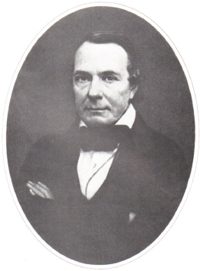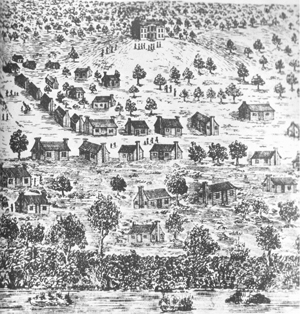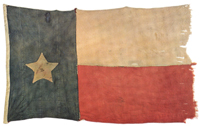 A LITTLE PIECE OF HISTORY | By Joan Frances Photos from The Old West: The Texans –
A LITTLE PIECE OF HISTORY | By Joan Frances Photos from The Old West: The Texans –
“The cultivated mind is the guardian genius of democracy and, while guided and controlled by virtue, the noblest attribute of man. It is the only dictator that freemen acknowledge and the only security that freemen desire.” – Mirabeau Buonaparte Lamar
The state of Texas is so fortunate to have a history of strong, aggressive leaders who set out to establish a foundation that would withstand the test of time, beginning with Stephen F. Austin and the first adventuresome Americans who set into motion the fruition of Texas farmers and ranchers. Then came Sam Houston, the first President of Texas, who battled Indians and Mexico to assure Texans independence. The second elected President of Texas was a painter, poet, publisher and a magnetic politician named Mirabeau B. Lamar.

The imposing structure on the hill was President Lamar’s house near Congress Avenue in Austin.
Born near Louisville, Georgia on August 16, 1789, Lamar was an avid reader, expert horseman and accomplished fencer. He married Tabitha Jordan in 1826 and had a daughter, Rebecca Ann, but four years later, Tabitha tragically died of tuberculosis. Lamar followed James W. Fannin, Jr. to Texas in 1835 to collect historical data. He decided to settle there, and soon after, he fought for Texas independence and helped build a fort at Velasco.
In September 1836, Lamar was elected Vice President of Texas and organized the Philosophical Society of Texas. He was considered a war hero and ran for the presidency in 1838, promising a national bank, a public system of education and harsh action against indians on Texas soil. At 40 years old, Lamar swept the election with 6,995 votes to 252 votes for his competitor, Robert Wilson.
As President, Lamar experienced difficult times. Mexico was threatening to reconquer Texas, there was no money in the treasury, currency was depreciated and the indians were rebellious. Lamar set out to improve this precarious situation. He orchestrated roads, schools, a permanent national capital in Austin and a banking system. He also launched a costly program of government activity in an effort to rebuild the Texas army for protection against Mexico and the indians.

The Texas Flag Act was a bill describing the Lone Star Flag, which became the second official flag of the Republic of Texas. The bill was passed by the Texas Congress on January 21, 1839 and approved by President Lamar on January 25, 1839.
One of the most positive and progressive moves during Lamar’s administration was to advocate and obtain passage of the Education Act of 1839. Under the act, three leagues were set aside in each county for the establishment of public schools, with one league equaling 4,428 acres. This insightful move left a significant impression on the future of Texas. As a result, President Lamar is remembered as the Father of Texas Education. Other significant bills signed were the Texas Flag Act, the Homestead Act, the Texas Bar Act and the Texas State Library. Lamar’s contributions to Texas with the passing of these bills 176 years ago still impact lives today.
Lamar was also a renowned poet and artist, who was a quiet, private man devoted to family and friends. In 1841, after his three-year term, he retired to his home near Richmond and worked on his plantation. Tragedy struck again when Lamar’s daughter died, which inspired him to write “On the Death of My Daughter” and was printed in the Southern Literary Messenger. In 1857, Lamar published a book of poems called Verse Memorials.
On December 19, 1859, Lamar died of a heart attack at his Richmond home and was buried in the Masonic Cemetery in Richmond. The City of Richmond gave tribute to Lamar at the 5th Annual Memorial Ceremony held on Monday, January 26, 2015 honoring this devoted Texan. Reflections of Lamar’s accomplishments and a celebration of his life were made, assuring this chapter of the history of the Republic of Texas will never be forgotten.